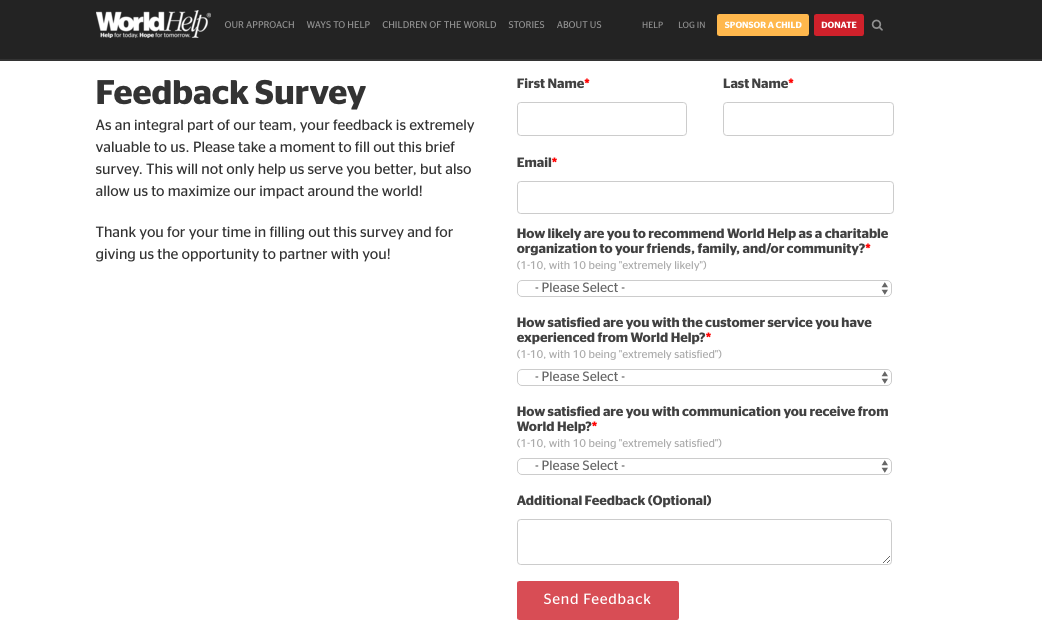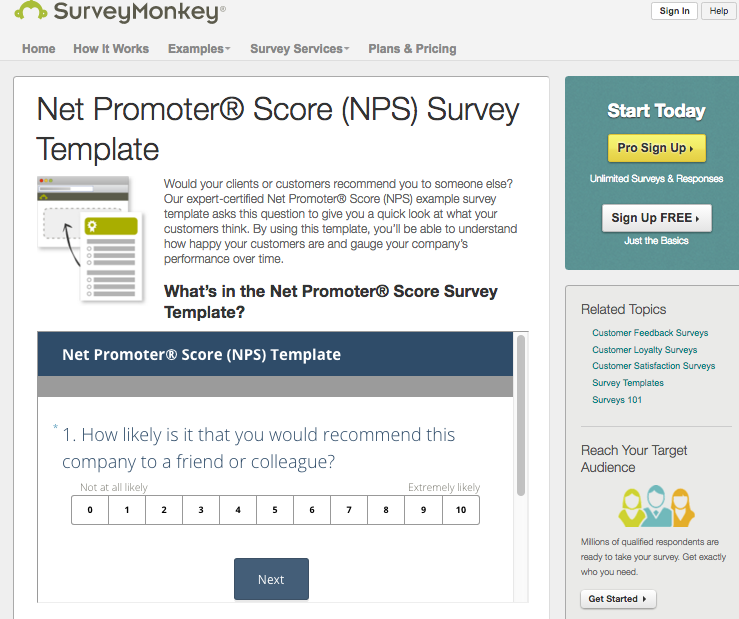What is Net Promoter Score (NPS)?
Net Promoter Score is a simple way to gauge the loyalty of your donor base. Nonprofits around the world have been using different versions of NPS to analyze their donor satisfaction since the early 2000’s.
Many nonprofits and businesses use the information gathered from the NPS survey to determine what type of relationship exists between the organization and its donors/customers. In a way, it is similar to a customer satisfaction survey that you’d complete following a trip to the grocery store or after purchasing a new car.
 Source: Netpromoter
Source: Netpromoter
“Net Promoter Score is a simple way to gauge the loyalty of your donor base…” tweet this
Why Is It Important?
Figuring out if your donors view your nonprofit in a positive light seems pretty straightforward. After all, if they are connected to your nonprofit, chances are they believe in the work you are doing.
But, it isn’t always so simple.
NPS takes into account your donor/client/customer’s view of your nonprofit by asking whether they would recommend your organization. This straightforward question can help you determine if you’ve got a loyal donor base, or may need to work on retention through engagement and education.
What Does An NPS Survey Look Like?
NPS surveys are simple, straightforward and usually very user-friendly. Sometimes, a nonprofit may ask the survey participant for their contact information, including name and email address.
Then, one question is presented: How likely are you to recommend our organization?
Oftentimes, nonprofits use this survey opportunity to ask the participant a few additional questions that can help them to better understand the participant’s reasoning behind the answer to the first question. Variations of the following are common:
- How satisfied are you with our work?
- How satisfied are you with our communications?
- How satisfied are you with our response to you?
All questions should require the participant to rank the nonprofit on a scale from 0 to 10, with 10 meaning highly likely and 0 meaning not at all likely.
Check out this great example from World Help. Their NPS survey is contained on a separate page on their website and it asks for the respondent’s contact information, along with 3 separate questions. Also, note the extra space to insert additional comments. This feature can be very helpful if someone wants to expand on their numerical answer.

If you want to try a different approach, use a survey generator such as Survey Monkey to send out an NPS survey to your email list. This image of the Survey Monkey NPS preview shows a simple, one-question NPS survey.

How Is The Data Analyzed?
The data that is gathered from the NPS is based on the main question: How likely are you to recommend our organization?
Respondents have chosen a number between 0 and 10, depending on the likelihood of recommendation. Here’s a breakdown of what the numbers mean.
Score 9 & 10: These are your PROMOTERS. They are your loyal base of donors, service recipients, and customers that are likely to remain a part of the fabric of your organization for years to come. Promoters help promote organizational growth.
Score 7 & 8: These are your PASSIVES. They are indifferent to your organization. They aren’t necessarily harmful to your overall image, but they also don’t provide positive referrals or add value. Oftentimes, this group is attracted to the appeal of other nonprofits and are easily swayed from your organization. Though passive responses are helpful to provide insight for your organization, this data is not considered when calculating NPS.
Score 0-6: These are your DETRACTORS. They are oftentimes unhappy with the direction of your organization and are more likely to spread negative feedback, which can directly impact your organization’s growth.
To calculate your NPS, subtract the percentage of detractors from the percentage of promoters.
For example, if 75% of your respondents were promoters and 15% were detractors, then:
Promoters: 75%
Detractors: 15%
Net Promoter Score = 60%
“The data that is gathered from the NPS is based on the main question: How likely are you to recommend our organization?” tweet this
What Does My Score Mean?
The more respondents answer positively to recommending your organization, the higher your NPS will be.
Therefore, scores over 50% indicate a positive and possibly growth-oriented organization, while those under 50% are indicative of a potential problem within the organization.
What Should You Do With This Data?
Once you’ve completed the survey and calculated your data, you should now have a good idea of how your survey participants feel about your organization. But this is not the point where you just go about business as usual. It is time to act on this data.
The question to now ask is: why did respondents answer this way?
If you received an overall positive NPS, then you know that you are providing a service that provides value. Remember to keep a focus on providing exceptional customer service to clients, following your mission, engaging your donors, and making sound business decisions.
On the other hand, an NPS of less than 50% means that you must find the root cause of unhappiness or negative perception about your organization. If you didn’t ask your respondents to add additional comments or detail the reasoning behind their score on the original survey, then consider following up using one (or more) of the following suggestions:
- Create an in-depth survey that asks respondents to explain their reasoning. Ask specific questions regarding communications, marketing, personalexperiences, etc. Give the participant space to write open-ended answers.
- Follow up with a quick survey that asks the respondent: What can we do to improve?
- Host a forum or panel where your contacts can come and voice their opinions about the direction of your nonprofit.
“An NPS of less than 50% means you must find the root cause of unhappiness or negative perception about your nonprofit “ tweet this
Is NPS the Best Way to Understand Nonprofit Loyalty?
You may be wondering whether one (or two) questions really provide your organization with a solid understanding of your perception. The answer is no. That’s why it is very important to focus on creating next steps to address any negative feedback you receive during this process.
In fact, many statisticians, businesses, and nonprofits have found that while calculating NPS can give them a good indicator of overall loyalty, the method lacks follow-through.
Ultimately, it is up to you and your organization to take your NPS results one step further. Your course of action will depend on your score, your resources, and your overall mission. However, determining your NPS is a great first step when helping to determine your organization’s overall health and growth potential.




